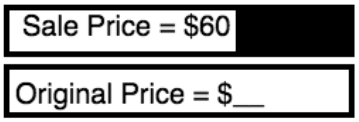1.4: Quantitative Analysis
( \newcommand{\kernel}{\mathrm{null}\,}\)
Quantitative Analysis: An Illustrative Example
Quantitative Analysis is the practice of analyzing the quantities in a situation. It is an important part of solving application problems because one cannot truly understand a problem that involves quantities (something one should do before trying to solve a problem) without understanding what each quantity represents and how it relates to other quantities.
Let's look at Exercise 58 from Section 3.1 of the OpenStax textbook Elementary Algebra, Second Edition.
Travis bought a pair of boots on sale for $25 off the original price. He paid $60 for the boots. What was the original price of the boots?
To analyze the quantities, we must be able to identify them.
Identify the quantities in this exercise. Determine if each quantity is relevant to the problem we are trying to solve. If the value of the quantity is known, state the value.
Travis bought a pair of boots on sale for $25 off the original price. He paid $60 for the boots. What was the original price of the boots?
Solution
- Travis bought a pair of boots. So, there are two boots. This is not relevant to the problem we are trying to solve, however, because everything is about the pair, not each boot individually.
- The boots had an original price. This is relevant to the problem since that is what we are asked to find. We do not know this value.
- The boots had a sale price. This is relevant to the problem because it is related to the original price. The sale price is $60.
- The boots were discounted. This is relevant to the problem since the discount tells us how the original price and the sale price are related. The discount is $25.
Sometimes people like to draw pictures to show relationships between quantities. This is not necessary to every use of Quantitative Analysis, but it is an option. Someone might draw something somewhat literal, in this case maybe stacks of money or even individual bills. Someone might instead draw something more abstract. Let's see an example of that.

In the image above, we see a representation of the sale price, the original price, and the fact that the sale price is less than the original price. The amount by which the sale price is less than the original price is represented by the black rectangle.
With or without the picture, we want to ask ourselves, how the quantities are related. In our identification of the quantities, we noted that the discount tells us how the other two important quantities (the original price and the sale price) are related. Since the boot are "on sale for $25 off the original price", this means that the sale price is the result of taking the discount away from the original price. Let's describe that mathematically.
Write a mathematical equation representing the fact that the sale price (which is $60) is the result of taking the discount (which is $25) away from the original price (which is unknown).
Solution
$60 = Original Price – $25
Now that we have represented the relationship between the quantities and we know which quantity we are trying to find, we can find that quantity using one of many strategies. In this course, you will learn about many strategies from the perspective of a teacher. But you have already learned this, so use whichever strategy you like to find the original price. Then check your answer below.
Solve the exercise.
Travis bought a pair of boots on sale for $25 off the original price. He paid $60 for the boots. What was the original price of the boots?
Solution
Since $60 = Original Price – $25, we know $60 +$25 = Original Price. 60+25 = 85, so the original price of the boots is $85.

